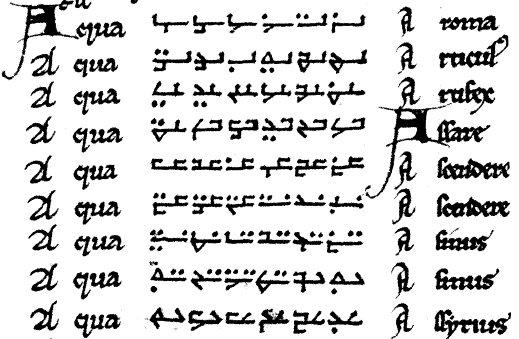The Cistercian links to the cult of Mary Magdalene
How were the medieval Cistercians different?
Cistercians in the medieval Holy Land - a slow and limited start
The novel lifestyle of medieval Cistercians - more labour, less liturgy
The Ciphers of the Cistercians
The medieval Cistercian numerals, or 'ciphers' in 19th-century parlance, were developed by the Cistercian monastic order in the early 13th century at about the time that Arabic numerals were introduced to northwestern Europe. They are more compact than Arabic or Roman numerals, with a single character able to indicate any integer from 1 to 9999. Is this cipher secret or occult?
Key qualities of the Cistercian Order: simplicity, practicality and self-sufficiency
"The promotion of the tenets of their faith on one hand and desire to return to the simplicity of early monasticism on the other, permitted the Cistercians (...) art and architecture. (...) As St Bernard envisaged the Earth as the work of Divine Architect, he himself as a head of his order, actively participated in many practical aspects of founding new Cistercian monasteries, including solving concrete architectural problems. (...)
Map of medieval monasteries in the Netherlands published
The founding of a Cistercian abbey, a good investment
"The founding of a Cistercian abbey was a comparatively cheap investment, in comparison to other monastic orders. The patrons, while seeking the spiritual rewards from charity, were also looking to develop their land. The Cistercians ventured into the wilderness to seek self sufficiency, a Cistercian abbey depended on cultivating a great expanses of wasteland, woodland and marshland.
The Rule of St. Benedict Compared with the Rule of the Templars
Knights Templar and Papal bulls: Milites Templi (1144)
The Templar Rule and the Cistercian influence
 |
Gregorian reform at the root of Cistercian monasticism
"The Gregorian Reforms (initiated by Pope Gregory VII and the circle he formed in the papal curia, c. 1050–80, dealt with the moral integrity and independence of the clergy, TN). This reform inspired others to seek a monastic life far from the secular world and all its excesses and greed, to a life based around control of desire, and the strict discipline of the rules of the desert fathers.
Many new orders were formed, namely Benedictine and Augustinian. Of these new orders, it was the Cluniacs that dominated in the monastic aspect of the Church (which in the medieval period was much more significant). The Cluniacs sought to follow the Rule of St Benedict, taking vows of obedience and poverty. The importance of the Cluniacs in this innovative period cannot be understated; ‘At the end of the eleventh century, at the height of its magnificence, Cluny was the head of a huge monastic empire containing many hundreds of dependencies and associated houses spread throughout western Europe....
The Cistercian Order finds its origins in the Cluniac monastery. It was from the abbey of Molesme, that Robert of Molesme with other monks, including Stephen Harding, left in search of a monastic life of stricter poverty than had been seen hitherto by the Cluniacs....The Cistercian, though he lived a communal life, had his salvation very much in his own hands than his Cluniac cousin: he was expected to do more to eradicate his own sins than to pray for the forgiveness of others. This illustrates some other differences between the two reformist orders.
The early Cistercians sought an isolated place, rejecting the world, to pursue this vocation.... The history of the Cistercian Order is integral to the history of western monasticism....Indeed, the history of the Cistercian Order is so intertwined with the history of medieval Europe as a whole, that it is hard to identify which influenced the other more."
This blog quotes freely from the thesis by Lori Firth, Hull University (2012): "A Comparison of the Cistercian and Knights Templar Orders, And the Personal Influence of Bernard of Clairvaux", to be found here. References in this source. Illustration shows Pope Gregory VII source
The origin of the Cistercian Order by its own account: Exordium Parvum
The Cistercian link to the birth of the Knights Templar 1104-1129
The years 1104 till 1129 are key years of the history of the Knights Templar: the years of origin. What happened in that timespan? And what were the links with that other juvenile Order, the Cistercians?




.webp)




.png)

